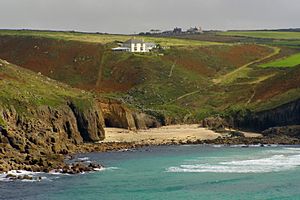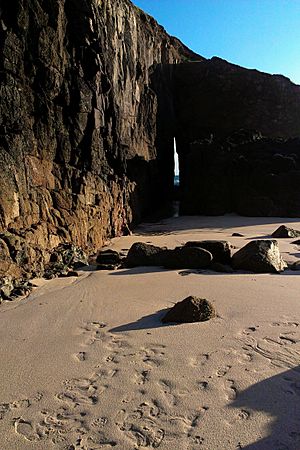Nanjizal facts for kids
Nanjizal (which means Cove of the low valley in the Cornish language) is a stunning beach and cove in Cornwall, United Kingdom. It's also known as Mill Bay. This hidden gem is located about one mile southeast of Land's End, a famous landmark. You can't drive directly to Nanjizal. Most people reach it by walking along the South West Coast Path. You can start your walk from Land's End to the north or from Porthgwarra to the south. Nanjizal is also a fantastic spot for watching birds!
Contents
Exploring Nanjizal's Geography
Nanjizal is a special cove and valley that opens up to the west, facing the huge Atlantic Ocean. On its north side, you'll find the tall cliffs of Carn Boel and Trevilley Cliff. To the south, there are more cliffs called Carn Lés Boel and Higher Bosistow Cliff. The beach itself changes a lot! Sometimes it's sandy, and other times it's covered in large rocks, depending on the tides and storms.
Cool Rock Formations at Nanjizal
To the south of the beach is a cool rock formation called Zawn Pyg. It's also known as the 'Song of the Sea'. This is a natural arch where the ocean has carved a tall, narrow tunnel through the rock over many years. Near Zawn Pyg, you'll find big rock pools called Big and Little Muzzan. These pools are full of interesting sea creatures like sea anemones and different kinds of seaweed. To the north, look out for a unique rock near the cliff that looks like a horse – it's called the 'Diamond Horse'. There are also other caves along the beach to explore!
A Shipwreck Story at Nanjizal
Nanjizal has a fascinating history, including a shipwreck! A ship called the City of Cardiff was a collier, which means it carried coal. On March 20, 1912, it was heading home to Cardiff when a strong storm hit. The ship struggled against the gale, trying to get around Land's End.
The City of Cardiff Runs Aground
By 11:00 AM, the storm was too powerful. The ship couldn't move forward and had to drop anchor about a mile south of Land's End. Even with its engines running at full power, the City of Cardiff slowly drifted towards the shore. A sudden strong gust of wind pushed it onto the rocks. The ship ended up on the beach as the tide came in. Luckily, the crew, two wives, and a two-year-old child were all rescued! A special team used a rocket apparatus to carry everyone safely to land. If you visit Nanjizal at low tide, you might still be able to see parts of the ship's remains.
Wildlife and Nature at Nanjizal
Nanjizal is a very important place for nature. It's part of the Porthgwarra to Pordenack Point Site of Special Scientific Interest (SSSI). This area is protected because of its amazing granite cliffs and unique maritime heath plants.
Birdwatching Paradise
The valley at Nanjizal is a special spot for birdwatchers and scientists. A group called the West Cornwall Ringing Group regularly studies the birds here. They catch birds, carefully measure them, and put a small ring on their leg before releasing them. This helps them track bird movements and populations.
Many different types of birds live and breed here, including:
- Common chiffchaff
- Common whitethroat
- Dunnock
- Eurasian blackcap
- Eurasian wren
- Sedge warbler
Other interesting birds that visit Nanjizal include:
- Brambling
- Cirl bunting
- Common grasshopper warbler
- Eurasian siskin
- Lesser redpoll
- Subalpine warbler
Rare Bird Sightings
Nanjizal is also famous for rare bird sightings! In the autumn of 2014, some very unusual birds were spotted and ringed, like the aquatic warbler, barred warbler, and paddyfield warbler. A truly exciting event happened on October 8, 2008, when an alder flycatcher was found here. This was the very first time this bird had ever been recorded in Britain! Another first for Cornwall happened on September 2, 2015, when a Blyth's reed warbler was ringed. These rare sightings show how important Nanjizal is for birds.
Images for kids








